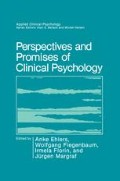Summary
After treatment by exposure in vivo and response prevention, forty-nine out of sixty-two obsessive-compulsive patients were followed for approximately 3.5 years. Compared to participators, the thirteen patients who did not participate had more initial obsessive-compulsive (OC) anxiety and depression, which nevertheless improved similarly by posttreatment. At 3.5 years follow-up, gains were maintained on all measures with no relapse. Eighty-four percent of the patients were “improved” or “much improved”, indicating that exposure in vivo and response prevention was successful in the treatment of obsessive compulsive disorders.
A number of initial patient characteristics only marginally predicted therapy outcome. Approximately one quarter of the total variance could be explained. The predictor variables, however, discriminated about sixty to seventy percent of good from poor therapy outcomes at posttreatment and long-term follow-up respectively. Higher initial OC-anxiety and depression, higher onset age, and more negative rearing practices resulted in poorer therapy outcome.
The effectiveness of behavioral treatment for obsessive-compulsive disorders has been demonstrated in a number of studies (for an overview see Emmelkamp, 1982). One of the most successful treatments found, was exposure in vivo and response prevention. In these studies, the follow-up of treatment effects occurred mainly between one and six months after treatment Follow-up studies after approximately two years were reported by Boulougouris (1977), Kasvikis & Marks (1988), Marks et al. (1975), and Mawson et al. (1982).
The aim of the present study was to evaluate the effects of behavioral treatment approximately 3.5 years after treatment. A further aim of this study was to examine the possible relationship of patient characteristics to therapy outcome at posttreatment and follow-up after 3.5 years. The selection of the prognostic variables to be investigated was partly based on the results of previous investigations of Foa et al. (1983) and Hoogduin & Duivenvoorden (1988). In the Foa et al. study (1983), onset age, initial depression, and initial obsessive-compulsive anxiety were found to correlate with outcome at posttreatment or follow-up.
Since negative parental rearing practices (rejection by the parents, lack of emotional warmth, and overprotection) have been found to be associated with obsessive compulsive disorders (Emmelkamp, 1982; Hoekstra, Visser & Emmelkamp, 1989), the present study also adressed the question of whether parental characteristics affect treatment outcome.
Access this chapter
Tax calculation will be finalised at checkout
Purchases are for personal use only
Preview
Unable to display preview. Download preview PDF.
References
Arrindell, W.A., Emmelkamp, P.M.G., Brilman, E. & Monsma, A. (1983). Psychometric evaluation of an inventory for assessment of parental rearing practices. Acta Psychiatrica Scandinavia, 67, 163–177.
Basoglu, M., Lax, T., Kasvikis, Y. & Marks, I.M. (1988). Predictors of improvement in obsessive-compulsive disorder. Journal of Anxiety Disorders, 2, 299–317.
Beech, H.R. & Vaughan, M. (1978). Behavioral treatment of obsessional states. New York: Wiley.
Boulougouris, J.C. (1977). Variables affecting outcome in obsessive-compulsive patients treated by flooding. In: Boulougouris & Rabavilas (Eds.), Treatment of phobic and obsessive-compulsive disorders. Oxford: Pergamon.
Cooper, J. (1970). The Leyton Obsessional Inventory. Psychological Medicine, 1, 46–48.
Emmelkamp, P.M.G. (1982). Phobic and Obsessive-Compulsive Disorders. New York: Plenum.
Emmelkamp, P.M.G., Helm, M. van de, Zanten, B. van., & Plochg, I.(1980). Contributions of self-instructional training to the effectiveness of exposure in vivo: A comparison with obsessive-compulsive patients. Behavior Research and Therapy, 18, 61–66.
Emmelkamp, P.M.G., Hoekstra, RJ. & Visser, S. (1983). The behavioral treatment of obsessive-compulsive disorder, prediction of outcome at 3.5 years follow-up. In: Benner & Pichot (Eds.), Psychiatry, Current States. New York: Plenum Press.
Emmelkamp, P.M.G. & Kraanen, J. (1977). Therapist controlled exposure in vivo versus self-controlled exposure in vivo: A comparison with obsessive-compulsive patients. Behaviour Research and Therapy, 15, 491–495.
Emmelkamp, P.M.G. & Lange, Lde (1983). Spouse involvement in the treatment of obsessive-compulsive patients. Behaviour Research and Therapy, 21, 341–346.
Emmelkamp, P.M.G. & Rabbie, D. (1981). Psychological treatment of obsessive-compulsive disorder. In: Jansson, Perris & Struwe (Eds.), Biological Psychiatry. Amsterdam: Elsevier.
Emmelkamp, P.M.G., Visser, S. & Hoekstra, RJ. (1988). Cognitive therapy vs exposure in vivo in the treatment of obsessive-compulsives. Cognitive Therapy and Research, 12, 103–144.
Foa, E.B., Doppelt, H.G., Turner, R.M. & Latimer, P.R. (1983). Success and failure in the behavioral treatment of obsessive-compulsives. Journal of Consult. Clinical Psychology, 51, 287–297.
Hoekstra, R.J., Visser, S. & Emmelkamp, P.M.G. (1989). A social learning formulation of the etiology of obsessive compulsive disorders. In: Emmelkamp, Everaerd, Kraaymaat & van Son (Eds.), Fresh Perspectives on Anxiety Disorders, Amsterdam, Swets.
Hoogduin, C.A.L. & Duivenvoorden, HJ. (1988). A decision model in the treatment of obsessive-compulsive neurosis. British Journal of Psychiatry, 152, 516–521.
Kasvikis, Y. & Marks, LM. (1988). Clomipramine, self-exposure, and therapist-accompanied exposure in obsessive-compulsive ritualizers: two-year follow-up. Journal of Anxiety Disorders, 2, 291–298.
Marks, I.M., Hodgson, R. & Rachman, S. (1975). Treatment of chronic OCD 2 years after in vivo exposure. British Journal of Psychiatry, 127, 349–364.
Mawson, D., Marks, LM. & Ramm, E. (1982). Clomipramine and exposure for chronic OC rituals: III. Two year follow-up. British Journal of Psychiatry, 140, 11–18.
Penis, C., Jacobsson, L., Lindstrom, H., Knorrig, L. van & Penis, H. (1980). Development of a new inventory for assessing memories of parental rearing behaviour. Acta Psychiatrica Scandinavica, 61, 265–274.
Rachman, S. & Hodgson, R.J. (1980). Obsessions and compulsions. New York: Prentice-Hall.
Watson, J.P. & Marks, LM. (1971). Relevant and inelevant fear and flooding. Behavior Therapy, 2, 275–293.
Zung, W.W.K. (1965). A self rating depression scale. Archives of General Psychiatry, 12, 63–70.
Author information
Authors and Affiliations
Editor information
Editors and Affiliations
Rights and permissions
Copyright information
© 1991 Springer Science+Business Media New York
About this chapter
Cite this chapter
Visser, S., Hoekstra, R.J., Emmelkamp, P.M.G. (1991). Long-Term Follow-up Study of Obsessive-Compulsive Patients after Exposure Treatment. In: Ehlers, A., Fiegenbaum, W., Florin, I., Margraf, J. (eds) Perspectives and Promises of Clinical Psychology. Applied Clinical Psychology. Springer, Boston, MA. https://doi.org/10.1007/978-1-4899-3674-5_14
Download citation
DOI: https://doi.org/10.1007/978-1-4899-3674-5_14
Publisher Name: Springer, Boston, MA
Print ISBN: 978-1-4899-3676-9
Online ISBN: 978-1-4899-3674-5
eBook Packages: Springer Book Archive

